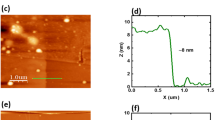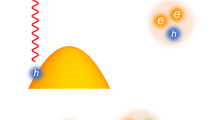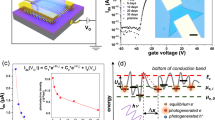Abstract
The development of light-emitting diodes with improved efficiency, spectral properties, compactness and integrability is important for lighting, display, optical interconnect, logic and sensor applications1,2,3,4,5,6,7,8. Monolayer transition-metal dichalcogenides have recently emerged as interesting candidates for optoelectronic applications due to their unique optical properties9,10,11,12,13,14,15,16. Electroluminescence has already been observed from monolayer MoS2 devices17,18. However, the electroluminescence efficiency was low and the linewidth broad due both to the poor optical quality of the MoS2 and to ineffective contacts. Here, we report electroluminescence from lateral p–n junctions in monolayer WSe2 induced electrostatically using a thin boron nitride support as a dielectric layer with multiple metal gates beneath. This structure allows effective injection of electrons and holes, and, combined with the high optical quality of WSe2, yields bright electroluminescence with 1,000 times smaller injection current and 10 times smaller linewidth than in MoS2 (refs 17,18). Furthermore, by increasing the injection bias we can tune the electroluminescence between regimes of impurity-bound, charged and neutral excitons. This system has the required ingredients for new types of optoelectronic device, such as spin- and valley-polarized light-emitting diodes, on-chip lasers and two-dimensional electro-optic modulators.
This is a preview of subscription content, access via your institution
Access options
Subscribe to this journal
Receive 12 print issues and online access
$259.00 per year
only $21.58 per issue
Buy this article
- Purchase on Springer Link
- Instant access to full article PDF
Prices may be subject to local taxes which are calculated during checkout




Similar content being viewed by others
References
Chen, J. et al. Bright infrared emission from electrically induced excitons in carbon nanotubes. Science 310, 1171–1174 (2005).
Marty, L. et al. Exciton formation and annihilation during 1D impact excitation of carbon nanotubes. Phys. Rev. Lett. 96, 136803 (2006).
Mann, D. et al. Electrically driven thermal light emission from individual single-walled carbon nanotubes. Nature Nanotech. 2, 33–38 (2007).
Kioseoglou, G. et al. Intershell exchange and sequential electrically injected spin populations of InAs quantum-dot shell states. Phys. Rev. Lett. 101, 227203 (2008).
Xia, F., Steiner, M., Lin, Y. & Avouris, P. A microcavity-controlled, current-driven, on-chip nanotube emitter at infrared wavelengths. Nature Nanotech. 3, 609–613 (2008).
Essig, S. et al. Phonon-assisted electroluminescence from metallic carbon nanotubes and graphene. Nano Lett. 10, 1589–1594 (2010).
Mueller, T. et al. Efficient narrow-band light emission from a single carbon nanotube p–n diode. Nature Nanotech. 5, 27–31 (2010).
Shambat, G. et al. Ultrafast direct modulation of a single-mode photonic crystal nanocavity light-emitting diode. Nature Commun. 2, 539 (2011).
Mak, K. F., Lee, C., Hone, J., Shan, J. & Heinz, T. F. Atomically thin MoS2: a new direct-gap semiconductor. Phys. Rev. Lett. 105, 2–5 (2010).
Splendiani, A. et al. Emerging photoluminescence in monolayer MoS2 . Nano Lett. 10, 1271–1275 (2010).
Cao, T. et al. Valley-selective circular dichroism of monolayer molybdenum disulphide. Nature Commun. 3, 887 (2012).
Feng, J., Qian, X., Huang, C-W. & Li, J. Strain-engineered artificial atom as a broad-spectrum solar energy funnel. Nature Photon. 6, 866–872 (2012).
Mak, K. F., He, K., Shan, J. & Heinz, T. F. Control of valley polarization in monolayer MoS2 by optical helicity. Nature Nanotech. 7, 494–498 (2012).
Xiao, D., Liu, G-B., Feng, W., Xu, X. & Yao, W. Coupled spin and valley physics in monolayers of MoS2 and other group-VI dichalcogenides. Phys. Rev. Lett. 108, 1–5 (2012).
Zeng, H., Dai, J., Yao, W., Xiao, D. & Cui, X. Valley polarization in MoS2 monolayers by optical pumping. Nature Nanotech. 7, 490–493 (2012).
Jones, A. M. et al. Optical generation of excitonic valley coherence in monolayer WSe2 . Nature Nanotech. 8, 634–638 (2013).
Sundaram, R. S. et al. Electroluminescence in single layer MoS2 . Nano Lett. 13, 1416–1421 (2013).
Ye, Y. et al. Exciton-related electroluminescence from monolayer MoS2 . Preprint at http://lanl.arXiv.org/abs/1305.4235 (2013).
Novoselov, K. S. et al. Two-dimensional atomic crystals. Proc. Natl Acad. Sci. USA 102, 10451–10453 (2005).
Mak, K. F. et al. Tightly bound trions in monolayer MoS2 . Nature Mater. 12, 207–211 (2013).
Ross, J. S. et al. Electrical control of neutral and charged excitons in a monolayer semiconductor. Nature Commun. 4, 1474 (2013).
Zhu, Z. Y., Cheng, Y. C. & Schwingenschlögl, U. Giant spin–orbit-induced spin splitting in two-dimensional transition-metal dichalcogenide semiconductors. Phys. Rev. B 84, 153402 (2011).
Yuan, H. et al. Zeeman-type spin splitting controlled by an electric field. Nature Phys. 9, 563–569 (2013).
Zhao, W. et al. Evolution of electronic structure in atomically thin sheets of WS2 and WSe2 . ACS Nano 7, 791–797 (2013).
Yin, Z. et al. Single-layer MoS2 phototransistors. ACS Nano 6, 74–80 (2012).
Lopez-Sanchez, O., Lembke, D., Kayci, M., Radenovic, A. & Kis, A. Ultrasensitive photodetectors based on monolayer MoS2 . Nature Nanotech. 8, 1–5 (2013).
Huang, J-K. et al. Large-area synthesis of highly crystalline WSe2 monolayers and device applications. ACS Nano 8, 923–930 (2014).
Korn, T., Heydrich, S., Hirmer, M., Schmutzler, J. & Schüller, C. Low-temperature photocarrier dynamics in monolayer MoS2 . Appl. Phys. Lett. 99, 102109 (2011).
Shi, H. et al. Exciton dynamics in suspended monolayer and few-layer MoS2 2D crystals. ACS Nano 7, 1072–1080 (2013).
Lagarde, D. et al. Carrier and polarization dynamics in monolayer MoS2 . Phy. Rev. Lett. 112, 047401 (2014).
Sim, S. et al. Exciton dynamics in atomically thin MoS2: interexcitonic interaction and broadening kinetics. Phys. Rev. B 88, 075434 (2013).
Yao, W., Xiao, D. & Niu, Q. Valley-dependent optoelectronics from inversion symmetry breaking. Phys. Rev. B 77, 235406 (2008).
Pospischil, A., Furchi, M. M. & Mueller, T. Solar-energy conversion and light emission in an atomic monolayer p–n diode. Nature Nanotech. http://dx.doi.org/10.1038/nnano.2014.14 (2014).
Baugher, B. W. H., Churchill, H. O. H., Yang, Y. & Jarillo-Herrero, P. Optoelectronic devices based on electrically tunable p–n diodes in a monolayer dichalcogenide. Nature Nanotech. http://dx.doi.org/10.1038/nnano.2014.25 (2014).
Acknowledgements
This work was mainly supported by the US Department of Energy, Basic Energy Sciences, Materials Sciences and Engineering Division (DE-SC0008145). N.G., J.Y. and D.M. are supported by the US DoE, BES, Materials Sciences and Engineering Division. W.Y. is supported by the Research Grant Council of Hong Kong (HKU705513P), the University Grant Committee (AoE/P-04/08) of the government of Hong Kong and the Croucher Foundation under the Croucher Innovation Award. D.C. is supported by the US DoE, BES, Materials Sciences and Engineering Division (DE‐SC0002197). Device fabrication was performed at the Washington Nanofabrication Facility and National Science Foundation-funded Nanotech User Facility.
Author information
Authors and Affiliations
Contributions
X.X. conceived the experiments. J.S.R. fabricated the devices and performed the measurements, assisted by P.K. and A.M.J. J.S.R. and X.X. performed data analysis, with input from D.C. and W.Y. N.G., J.Y. and D.G.M. synthesized and performed bulk characterization measurements on the WSe2 crystals. T.T., K.W. and K.K. provided boron nitride crystals. X.X, D.C., J.S.R and W.Y. wrote the paper. All authors discussed the results.
Corresponding author
Ethics declarations
Competing interests
The authors declare no competing financial interests.
Supplementary information
Supplementary information
Supplementary information (PDF 695 kb)
Rights and permissions
About this article
Cite this article
Ross, J., Klement, P., Jones, A. et al. Electrically tunable excitonic light-emitting diodes based on monolayer WSe2 p–n junctions. Nature Nanotech 9, 268–272 (2014). https://doi.org/10.1038/nnano.2014.26
Received:
Accepted:
Published:
Issue Date:
DOI: https://doi.org/10.1038/nnano.2014.26
This article is cited by
-
First-principles calculations of physical properties of the tungsten dichalcogenides (WSe2 and WTe2)
Chemical Papers (2024)
-
Reconfigurable logic and in-sensor encryption operations in an asymmetrically tunable van der Waals heterostructure
Nano Research (2024)
-
Lead halide perovskite sensitized WSe2 photodiodes with ultrahigh open circuit voltages
eLight (2023)
-
Dynamical characteristics of AC-driven hybrid WSe2 monolayer/AlGaInP quantum wells light-emitting device
Discover Nano (2023)
-
Strong coupling in plasmonic metal nanoparticles
Nano Convergence (2023)



